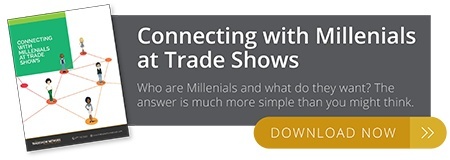It should come as no surprise that marketing to Millennials is not the same as marketing to other generations of consumers, which has big implications for trade shows and other events. The good news is that Millennials want to develop relationships with the businesses that reflect their interests, they prefer face-to-face interaction, and they identify with and support their favorite brands. The bad news is that they are hard to reach through traditional marketing approaches and channels. That means that trade show marketers need to create experiences in their exhibits that will draw in Millennial buyers.
 Who are the Millennials and what do they want?
Who are the Millennials and what do they want?
“The Millennials have surpassed Baby Boomers as the nation’s largest living generation,” reports the Pew Research Center, citing U.S. Census Bureau population estimates. “Millennials, whom we define as those ages 18-34 in 2015, now number 75.4 million, surpassing the 74.9 million Baby Boomers (ages 51-69). And Generation X (ages 35-50 in 2015) is projected to pass the Boomers in population by 2028. The Millennial generation continues to grow as young immigrants expand its ranks.”
According to blogger Tamar Frumkin, “Millennials grew up in a culture of internet and mobile, demanding constant online access, owning multiple connected gadgets, and are likely to choose to spend time with friends online instead of in person. Millennials, not renowned for their rigid attention spans, switch between laptops, smartphones, tablets, and TV more than 27 times an hour (Pew Research), and the vast majority use two or more devices simultaneously while watching TV. …Given the fact that the majority consider technology to be an actual part of their identity, (the Millennials) are clearly a consumer force to be reckoned with.”
So it begs the question: do Millennials, otherwise known as Generation Y, want the face-to-face interaction that a trade show event brings? Research indicates that positive, personal interaction can spur brand loyalty.
The Boston Consulting Group (BCG) states, “Millennials expect a two-way, mutual relationship with companies and their brands. We call this the reciprocity principle. Through the feedback they express both offline and online, Millennials influence the purchases of other customers and potential customers. They also help define the brand itself. The Internet, social media, and mobile devices greatly amplify Millennials’ opinions and accelerate their impact. Companies can expect that a positive brand experience will prompt Millennials to take favorable public action on behalf of their brand. A bad—or even just disappointing—experience can turn a Millennial into a vocal critic who will spread the negative word through social media, reviews, and blogs. And that criticism can go viral.”
The challenge for marketers at trade shows is to cultivate relationships in person, create a powerful brand experience in the booth, and support the effort with social media and technology.
Harnessing the power of face-to-face marketing
Trade shows can be targeted to either businesses or consumers. Either way, with Millennials in the workforce, exhibitors need to create an experience that will appeal to their preferences, as well as to older generations.
“It can be challenging for companies to adapt to the rapidly evolving needs of a huge new consumer base – especially when they are as nuanced and subtle as customer service expectations,” Frumkin observes.
As stated in previous blog articles, trade shows are where everything new starts. Companies that are exhibiting don’t bring their old stuff to put on display. They introduce the newest, greatest, and the best, which is why Millennials will flock to trade show events. They need to stay ahead of the game and want (and crave) the latest advances.
Following are tips on how to create a great exhibit experience for Millennials and other visitors.
Cultivate relationships between booth staff and attendees.
Let’s face it. Going into some booths can be daunting for attendees, especially if the staffers are talking with one another, looking bored, or even worse, ready to pounce on anyone within a ten-foot radius. Since marketing to Millennials requires building a relationship, booth staffers should look at interactions as a long-term investment. You may not sell anything to an attendee on the show floor, but you can make them want to do business with you in the future. A good place to start is by asking them about their interests and needs.
When it comes to cultivating relationships, the Boston Consulting Group advises, “To sustain Millennial loyalty to their brands, companies must engage Millennials individually and in small groups through direct, two-way communications. More than other generations, Millennials desire opportunities to interact with brands, to be listened to anywhere and anytime, and to have personal, timely, and straightforward communication about their concerns and experiences.”
When asked to name the most important things brands can do to “engage and interest” them in the BCG research, “… Their top two responses were to reward their loyalty with discounts and promotions and to ‘be authentic.’ These were also high on the lists of Gen-Xers and Boomers. But more Millennials than other generations also listed being available, supporting causes, and having a brand personality.”
At shows where giveaways and promotional items are allowed, make sure to match your promotional items to your brand identity. Consumer product exhibitors may want to offer samples or special offers. Business-to-business marketers with longer sales cycles may want to make a good first impression at the show and follow up later with an opportunity for more discussion. If your company supports a good cause, you may want to highlight your good works in your display.
Use technology to invite attendees into the conversation. In a recent blog article, Trade Show Event Technology that's Hot for 2016, we talked about how to incorporate technology effectively in your exhibit space.
Examples include:
- Instant content marketing, including event images and social media posts
- Video walls that serve as large-screen social media streams to provide real-time interaction that encourages people to participate
- Smart personalized content and alerts
- Interaction with wearable technology
- Event intelligence
Include trade show events as a strategic element of your marketing plan. In an article and infographic for Inc., Laura Montini points to in-person events as the marketing tactic of choice for B2B marketers.
In-person events, including trade shows, are still one of your best bets for marketing, because Millenials are looking for an experience with their preferred brands. They are pushing businesses to change their ways and put the customer first. They are exercising their influence and their voice through social media and personal referrals to their favorite brands. While many label this generation as selfish or entitled, marketers owe Millennials a tremendous amount of gratitude for helping to reshape customer service by raising the bar of expectation.
Millennials are here and are growing in numbers. Be sure to incorporate their buyer persona into your trade show marketing strategy.
Sources:
Millennials Overtake Baby Boomers as America’s Largest Generation, Pew Research CenterThe Future Of Customer Experience: How To Adapt For Millennials, Gen Z, And Beyond, by Tamar Frumkin, getresponse.com What the Smartest Content Marketers Have in Common (Infographic) by Laura Montini, reporter, Inc. The Reciprocity Principle, How Millennials are Changing the Face of Marketing Forever, Boston Consulting Group





